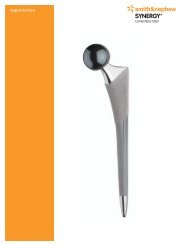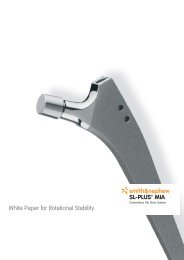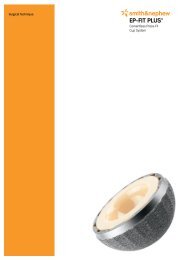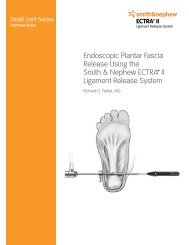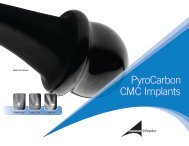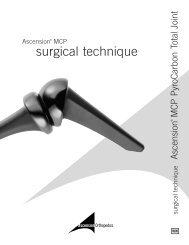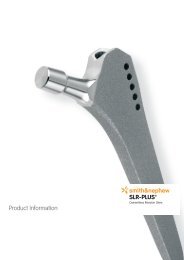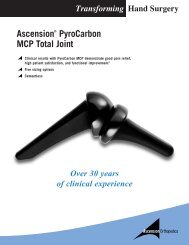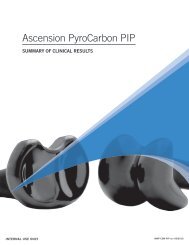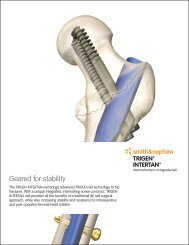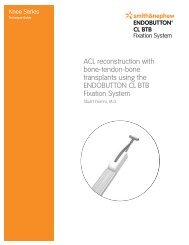BICEPTOR - Biceps - Smith & Nephew
BICEPTOR - Biceps - Smith & Nephew
BICEPTOR - Biceps - Smith & Nephew
You also want an ePaper? Increase the reach of your titles
YUMPU automatically turns print PDFs into web optimized ePapers that Google loves.
<strong>BICEPTOR</strong><br />
Tenodesis System<br />
Arthroscopic<br />
<strong>Biceps</strong> Tenodesis<br />
A Shoulder Series Technique Guide<br />
As described by:<br />
Scott Trenhaile, M.D.
As described by:<br />
Scott W. Trenhaile, M.D.<br />
Clinical Assistant Professor<br />
Orthopedic Surgery<br />
University of Illinois College of Medicine<br />
Rockford, Illinois<br />
2
Introduction<br />
The <strong>Smith</strong> & <strong>Nephew</strong> <strong>BICEPTOR</strong> Tenodesis System<br />
was created to provide a simplified procedure for<br />
biceps tenodesis. The <strong>BICEPTOR</strong> Tenodesis System<br />
does not require whipstitching the tendon, resulting in<br />
an efficient all-arthroscopic repair. In an all-arthroscopic<br />
repair, the surgeon does not need to pull the tendon out<br />
of the body, and repair is irrespective of body habitus or<br />
soft tissue swelling. The technique allows for maximized<br />
soft tissue-to-bone surface area and avoids the need<br />
for tendon resection prior to fixation. The ability to cut<br />
the tendon in the last step means less guesswork and<br />
more control over tensioning. The result is a strong<br />
repair using the BIOSURE PK Interference Screw.<br />
This device may be utilized in an all-arthroscopic<br />
supra-pectoralis location or in a mini open supra- or<br />
sub-pectoralis fashion.<br />
Patient Positioning<br />
Place the patient in either the lateral decubitus or beach<br />
chair position.<br />
Figure 1<br />
Portal Placement<br />
Create standard arthroscopic portals through which<br />
a diagnostic arthroscopy may be performed. These<br />
portals include a posterior soft spot portal, a rotator<br />
interval anterior portal, and possibly an anterior<br />
accessory portal. Address glenohumeral joint pathology<br />
prior to performing long head of biceps (LHB) tenodesis.<br />
1. Place a needle at the anterolateral edge of the<br />
acromion into the shoulder joint just anterior to the<br />
supraspinatus tendon and into the biceps (Figure 1).<br />
2. Introduce a #1 monofilament suture through the<br />
needle and biceps tendon. Retrieve the suture out<br />
the rotator interval portal (Figure 2).<br />
Figure 2<br />
3
Figure 3<br />
3. Remove the needle and retrieve the remaining arm<br />
of suture. With both arms exiting the rotator interval<br />
portal, tie half hitches onto the biceps for security of<br />
the tendon.<br />
4. For additional security, pass one of the suture limbs<br />
around the biceps again and tie with half hitches a<br />
second time to create a suture ligature effect.<br />
5. Cut the biceps tendon through the anterior interval<br />
portal at its insertion point onto the labrum but<br />
below the suture (Figure 3).<br />
Debride any biceps stump that remains on<br />
the labrum.<br />
6. Create a standard lateral portal to clear bursal tissue<br />
from the subacromial space. Arthroscopic tenodesis<br />
is recommended at this point.<br />
7. Create a biceps tenodesis portal by introducing a<br />
needle into the skin until the humerus is engaged.<br />
This portal is typically inferior and lateral to the<br />
rotator interval portal. March the needle laterally<br />
off the humerus and then back again medially to<br />
confirm the intertubercular bicipital groove location.<br />
Introduce a cannula and direct it superiorly after<br />
encountering the humerus so it can be visualized in<br />
the subacromial space (Figure 4).<br />
Figure 4<br />
4
Arthroscopic Dissection<br />
1. Perform a bursectomy down the face of the<br />
humerus anteriorly until the supra-pectoralis<br />
location is identified.<br />
2. Incise the transverse ligament between the<br />
lesser and greater tuberosity to identify the LHB<br />
in the groove.<br />
3. Use arthroscopic scissors to unroof the biceps more<br />
proximally until the rotator interval is reached.<br />
4. To determine the size of the BIOSURE PK<br />
Interference Screw needed, insert the small tendon<br />
fork and capture the tendon. If the tendon fits<br />
comfortably inside the small tendon fork, use a<br />
7.0 mm Endoscopic XL drill and a 7.0 mm BIOSURE<br />
PK Interference Screw. If the tendon does not fit<br />
comfortably within the fork, try a medium tendon<br />
fork and then a large tendon fork. The medium<br />
tendon fork corresponds to an 8.0 mm interference<br />
screw and the large tendon fork corresponds to a<br />
9.0 mm interference screw. Use line-to-line sizing<br />
for drilling the holes. For example, drill an 8.0 mm<br />
hole for an 8.0 mm screw.<br />
5. Use the tendon fork to move the biceps tendon to<br />
the side and find the desired location to tenodese<br />
the tendon. Place the tendon fork in this location<br />
and insert a 2.4 mm guide wire through the tendon<br />
fork, perpendicular to the humeral shaft in the<br />
bicipital groove.<br />
6. Remove the tendon fork, leaving the guide wire<br />
in place. Pass the appropriate corresponding<br />
Endoscopic XL drill over the guide wire through the<br />
anterior cortex (Figure 5).<br />
7. Drill 5 mm more than the interference screw length.<br />
Suggested reamer size corresponds to suggested<br />
screw size (an 8.0 mm reamer for an 8.0 mm screw).<br />
8. Remove the drill and guide wire. Using a shaver,<br />
clean soft tissue around the edge of the drill hole.<br />
This is an important step to enable insertion of the<br />
tendon and screw. At this point, optionally tap the<br />
hole with the corresponding size <strong>BICEPTOR</strong> Tap.<br />
Figure 5<br />
5
Figure 6<br />
9. Using the proximal sutures, tension the biceps<br />
tendon to return the LHB to the desired tension.<br />
The tendon fork is then introduced into the anterior<br />
cannula to capture the biceps tendon for insertion<br />
into the drill hole until the tendon reaches the far<br />
cortex (Figure 6).<br />
10. When pushing the tendon into the prepared hole,<br />
release the tension on the tendon to allow it to slide<br />
into the hole more easily.<br />
11. Put a Bi-Grip pin puller on the end of the 1.5 mm<br />
guide pin and insert through the cannulation in the<br />
tendon fork.<br />
12. Maintain tension on the monofilament sutures<br />
proximally and provisionally pin the tendon in place<br />
with a guide wire, traversing the far cortex using the<br />
tendon fork as a guide.<br />
13. Hammer the guide pin until the pin puller “bottoms<br />
out” on the tendon fork (Figure 7).<br />
14. Remove the pin puller and the tendon fork, leaving<br />
the guide pin in place. Make sure to completely<br />
release the tension on the monofilament and<br />
tendon when removing the tendon fork<br />
(Figure 7, inset).<br />
Figure 7<br />
6
15. Place the interference screw on the <strong>BICEPTOR</strong><br />
Driver and insert the interference screw over the<br />
guide pin (Figure 8).<br />
16. Remove the driver and pin and excise any excess<br />
tendon (Figure 9).<br />
17. If extra grip is required to remove the guide pin,<br />
replace the Bi-Grip pin puller on the guide pin<br />
and remove the guide pin.<br />
Figure 8<br />
Figure 9<br />
7
Additional Instruction<br />
Prior to performing this technique, consult the Instructions for Use documentation provided with individual<br />
components – including indications, contraindications, warnings, cautions, and instructions.<br />
Ordering Information<br />
To order the instruments used in this technique, call +1 800 343 5717 in the U.S.<br />
or contact your authorized <strong>Smith</strong> & <strong>Nephew</strong> representative.<br />
<strong>BICEPTOR</strong> Tenodesis Repair System<br />
<strong>BICEPTOR</strong> Tenodesis Repair Disposable<br />
Kits<br />
Kits include a BIOSURE PK Interference Screw,<br />
1.5 mm guide pin, and 2.4 mm guide wire<br />
REF<br />
Description<br />
72202299 7.0 x 15 mm <strong>BICEPTOR</strong><br />
Disposable Kit<br />
72202300 8.0 x 15 mm <strong>BICEPTOR</strong><br />
Disposable Kit<br />
72202301 9.0 x 15 mm <strong>BICEPTOR</strong><br />
Disposable Kit<br />
72202357 7.0 x 25 mm <strong>BICEPTOR</strong><br />
Disposable Kit<br />
72202358 8.0 x 25 mm <strong>BICEPTOR</strong><br />
Disposable Kit<br />
72202359 9.0 x 25 mm <strong>BICEPTOR</strong><br />
Disposable Kit<br />
REF 72202302 <strong>BICEPTOR</strong> Tenodesis<br />
Instrumentation Set includes:<br />
REF<br />
Description<br />
72202190 <strong>BICEPTOR</strong> Driver<br />
72202193 Tendon Fork, Small<br />
72202192 Tendon Fork, Medium<br />
72202191 Tendon Fork, Large<br />
72202194 Bi-Grip Pin Puller<br />
72202198 7.0 mm Endoscopic Drill, XL<br />
72202297 8.0 mm Endoscopic Drill, XL<br />
72202298 9.0 mm Endoscopic Drill, XL<br />
72202195 7.0 mm <strong>BICEPTOR</strong> Tap<br />
72202196 8.0 mm <strong>BICEPTOR</strong> Tap<br />
72202197 9.0 mm <strong>BICEPTOR</strong> Tap<br />
CAUTION: U.S. Federal law restricts these devices to sale by or on the order of a physician.<br />
Courtesy of <strong>Smith</strong> & <strong>Nephew</strong>, Inc.,<br />
Endoscopy Division<br />
*Trademarks of <strong>Smith</strong> & <strong>Nephew</strong>, Certain marks registered U.S. Patent & Trademark Office.<br />
Endoscopy<br />
<strong>Smith</strong> & <strong>Nephew</strong>, Inc.<br />
Andover, MA 01810<br />
USA<br />
www.smith-nephew.com<br />
+1 978 749 1000<br />
+1 978 749 1108 Fax<br />
+1 800 343 5717 U.S. Customer Service<br />
©2009 <strong>Smith</strong> & <strong>Nephew</strong>, Inc.<br />
All rights reserved.<br />
03/2009 10600476 Rev. A



